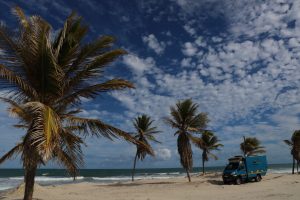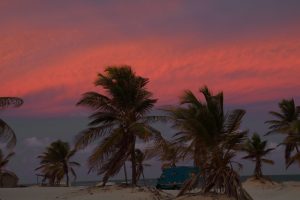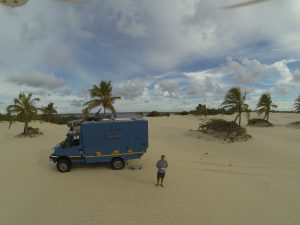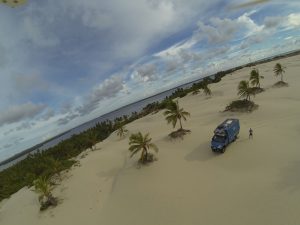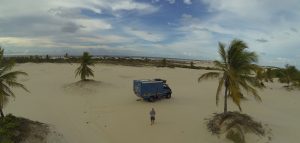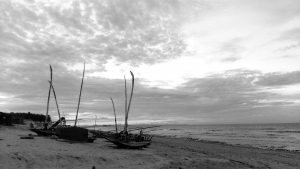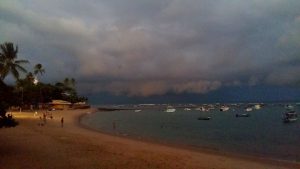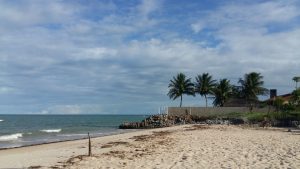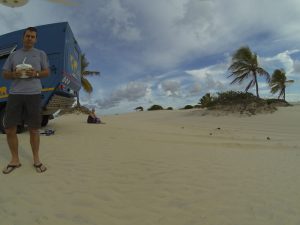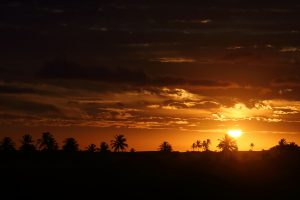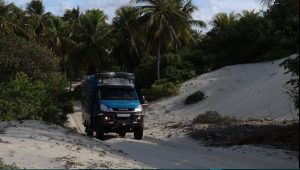Tudo bom… All good! The most common phrase we’ve heard all over Brazil. It’s a statement, it’s a question, it’s a greeting, it’s said with a smile and it’s a reflection of the consistently chirpy Brazilian nature which continues as we head into the far north. We’ve done middle Brazil. Now on this latest stretch we hit the coast at Salvador then head north: dodging coconuts, reaching the far east, dining with Iveco, and testing our nerves with Cuthbert’s capacity on dunes and deep-sand tracks.

Salvador, Bahia
Here’s a bit of trivia… where is the only place in Brazil from which you can watch the sun set over the ocean? “Hmmm…” you’re thinking… “Brazil’s coast is predominantly east facing, so where could that be???” Give in? OK, we’ll tell you… it is, we’re told, Salvador city in Bahia State. That’s obviously pretty useless trivia unless, of course, you happen to be in Salvador one sunny evening… in which case, you can gather with locals and other tourists on the grassy knoll by Farol da Barra to watch amazing sunsets from the end of the peninsula.
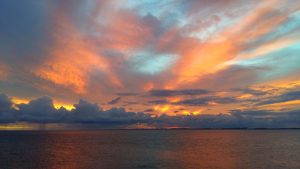
Salvador sunset
Salvador is a cool place with lots of character, history and a well-restored old town, but we’re not prepared for how extremely touristy the colonial centre is!! Sure, it’s a UNESCO world heritage site, so it’s going to be popular, but the cobbled streets are literally jam-packed full with wall-to-wall tourist-tat souvenirs and local youngsters touting for tips with entertaining displays of capoeira (a local marshal-art-style street dance hailing from the slave-trade era).
One fun way of seeing the two ‘tiers’ of Salvador is to use the lift to get from the sea-level port area to the old town immediately above on the cliff-top behind. Not merely a tourist attraction, it’s the commuter-transport-of-choice for many of the city’s workers going about their daily business. We had a pleasant day wandering the town, but a cool place though Salvador is, we don’t feel the urge to stay more than one day. We find a very central/convenient/safe place to park-up for the night in Cuthbert on the sea-front, but it is also on a main road… very much not our most peaceful night of the trip!
Hazard avoidance
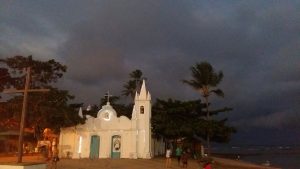
Praia do Forte
A couple of posts ago we were beach-hopping in southern Brazil with the dilemma of which of the many gorgeous beaches we should stop at. Now we face a similar problem, except we now have several thousand kilometres of beaches ahead of us rather than the several hundred kilometres that we had then! First is Praia do Forte with its turtle sanctuary and hatchery. Interesting place doing good work to save these beautiful creatures, but too close to Salvador to get away from the tourist crowds and over-hyped prices, so we headed a few hundred kilometres further north to a much less accessible spot.
Mangue Seco is a tiny hamlet sitting at the end of a long sandbank spit in the far north-eastern corner of Bahia State. A few day-trippers from nearby towns go there by boat for weekend sea-food lunches, but far fewer visitors attempt to get there by land, mostly because the only access is a deep, soft-sand track. We’re pretty sure that the fabulous Cuthbert (with his four-wheel drive, three diff-locks and high ground clearance) will handle it, but we still have to hold our nerve as we push on up the dunes. We’d look rather daft if we had to ask the locals for a tow-out, particularly when they only have dune-buggies themselves . The sand proves no problem but another hazard that Cuthbert faces is ducking and weaving around the many low-level cables that stretch across the tracks between the shacks in the village. Don’t think they really planned on anything as big as Cuthbert making it out this far and Cuthbert ripping out the power supply to the whole village wouldn’t be a great way to win friends and influence people.
- DCIM100GOPRO
- DCIM100GOPRO
Another hazard for Cuthbert in these parts is coconuts! Why so? Well… in the prevailing heat it’s nice to find a bit of shade to park under. Unfortunately, the only shade around here are the swaying palms which tend to be loaded with… surprise, surprise… coconuts! We watched a random coconut take an uninvited fall to the ground with a heavy thud and realised that it would be a bad thing for one to fall onto Cuthbert’s roof-top solar panels. We deploy some hazard-avoidance tactics and scoot around for a flat area to park-up without threat of bombardment.
Once we settle down, Marcus gets out the Phantom for a few aerial shots. We love having this with us but sadly haven’t been able to use it on our travels anywhere near as much as we’d like. Sometimes there are local regulations against using it, sometimes there are too many trees, but often the wind is simply too strong for it to handle.
Anyway… coconut-dodging aside, we love Mangue Seco and have a great time exploring, but (due to our limited entry-permit time in Brazil) we still have an unwanted time-schedule hanging around our proverbial necks. So much distance to cover in so little time, so we need to maintain momentum… northward bound.
Iveco Parts
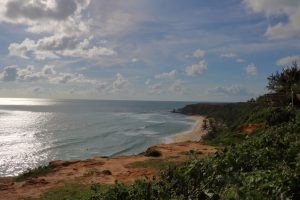
A view to wake-up to from Cuthbert 🙂
After more, lovely beachy stops (which aren’t in short supply along this coast), we’re heading towards the city of Recife. Here we hope to stock-up on some routine spare parts that Marcus wants to carry in Cuthbert as we head into the Amazon. Brazil is much more ‘Iveco country’ than the other countries in these parts, so we’re cautiously optimistic.
We find the Iveco outlet and make extensive use of Google Translate to communicate with the helpful chaps there. It’s a slow process and when it’s eventually time for the guys’ lunch break, they kindly take us with them to the small staff canteen where a lady had cooked a tasty selection of local dishes for us to lunch with them! Marvellous service here in Iveco (Navesa) Brazil!! Can’t imagine such thoughtfulness and kindness in European Iveco outlets. Sometime after the tasty lunch, we establish that they don’t actually hold in-stock all the parts that we need, but they can order them to arrive in four or five days. Bugger! We don’t really have that much time to hang around, but after some further exploitation of Mr Google Translate, we work out a plan that the parts will be ordered and sent to the Iveco Navesa in Fortaleza, some 800km further down our route for us to collect next week. Sounds good… if it works.
With full tummies and an optimistic plan to get Cuthbert’s spares in Fortaleza next week, we set off north. A few hours up the road, Marcus notices that Cuthbert’s speedo isn’t working and he’s lacking his usual acceleration power. Uh oh!! ‘Techie’ Tuck has a quick shufty underneath and reckons it’s probably the speed-sensor bust. Oh great… just after we had placed an order for Iveco spares we find something else that we need . Time for further investigations… some hours later, Marcus emerges from Cuthbert’s under-belly to announce it fixed!!! The sensor isn’t bust after all, it just wasn’t getting enough volts (or something like that, anyway). A bit of wiring replacement sorts it out and we’re good to go again. Phew! It’s handy having an on-board Techie to travel with
Far East
João Pessoa sits near the sticky-out corner of Brazil and in the city’s southern suburbs is Ponta do Seixas: the far-easterly geographical point, not just of main-land Brazil or of the South American continent, but of the whole of the Americas. The closest point to Africa.
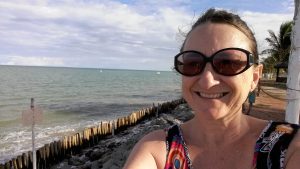
The far east – Leonardo waz ‘ere
Having been to the most southerly point of the continent near Ushuaia in Tierra del Fuego, Argentina, we thought we’d take Cuthbert for a quick photo opportunity at the most easterly point. Except we couldn’t. Unfortunately, no feature whatsoever has been made of this land-mark spot. On the point sits a private house with a barbed wire fence around it. Squeezing around the fence at low tide at the end of a nice little beach, you can see a tiny, scrappy sign (no more than a few inches square, set on a rough-cut iron pole) commemorating the end of adventurer Leonardo Meirelles’ 2015 trans-Brazil journey. But that’s it. Nothing else. And we couldn’t get Cuthbert anywhere near to take any photos . As an interesting aside, the noted achievement of Leonardo was to cross Brazil from the extreme westerly to the extreme easterly point under his own steam: 22km walking, 231 km rowing and 5,555 km cycling. On the face of it that seems a pretty tough gig, but when you look at the map to see exactly where the far westerly point of Brazil is, deep in the Amazon jungle far from tracks, paths or human existence of any kind, you can see how tough this journey must have been. Good job he didn’t have motor-vehicle though… he wouldn’t have been able to do a photo-op at the end .
Anyway… we’ve turned one of the biggest corners on the planet and we’re now heading west across to the top of Brazil.
Inevitably when tootling up a coastline there are river-mouths to cross. In Brazil the major rivers are bridged and the small ones tend to have short ferry crossings, but at one crossing we find the ‘ferry’ a bit on the small side for Cuthbert. The ferryman studies Cuthbert and reckons that we’ll make it across by fording the river. Now… we have learned from experience that successful river-fording is all about knowing the exact route to take, partly for the shallowest water, but importantly for the firmest ground to drive on. Having struggled down a very narrow track to get to the riverside, we reckon this probably isn’t a well-trodden route for heavy vehicles like Cuthbert. How gutting would it be, to drive into a shallow river only to sink axle-deep into the silty-sand mid-stream? (That’s a rhetorical question, by the way! Long term Cuthbert readers may recall that we had just such an incident a year ago back in Chile, so we do know exactly how gutting that situation is ). Anyway… we put our trust in the smiley ferry-man and hold our breath as we drive through the silty-soft riverbed. And…. Relax! Phew! Marcus put together a short video from the dash-cam (see below).
Jeri-what-really?
“Magical…” the book gushes “…its enchantment cannot be overstated…” it continues. Yeahy! Sounds good huh? Worth an short off-road sand-track drive to get there. The village looks nice enough from a distance, palm-trees swaying beyond the dunes. But when we arrive… . Have you ever had that sinking feeling of arriving in a much-anticipated location only to find that it simply doesn’t ‘cut the mustard’? Welcome to Jericoacoara in Ceará State, Brazil (Jeri to the cognoscenti 🙂 ).
Unfeasibly high expectations can be created by an over-enthusiastic travel-writer and we have rarely seen a better case of this than Jeri. Sure, it has lots of natural beauty, but you have to look hard to see it behind the crowds and cocktail-trollies on the beaches, the buggies racing around the dunes, the many party bars and the tat-souvenir sellers in the streets. Oh… and let’s not forget the quad-bikes, the many, many quad-bikes haring noisily about town. The centre is meant to be traffic-free, but that doesn’t include quad-bikes piled high with barely-dressed teenagers squealing their way in convoys to the dunes, beaches and bars. Maybe it’s our age? Have we turned into old-fogeys? Probably. But with the benefit of hind-sight, we would rather have given ‘Jeri-what-really?’ a miss.
After Jeri, there’s still another 1,300km of beautiful (mostly unspoiled) coast to go to the Amazon delta. Oh… and in case you’re wondering about the Iveco parts… all went well with the collection in Fortaleza. And not to be outdone by the canteen hospitality provided by the Recife guys, the Fortaleza guys took us out to a nearby local restaurant for lunch!! We’e now well stocked with ‘emergency spares’ Cuthbert, ready to tackle the less populated Amazon region. Big thanks to all the great people who helped us at the Iveco Navesa concessions in Brazil.
Link to next blog: Lencois Maranhenses – Dunes and Lagoons Link to full South America Blog
Gallery – Tudo Bom! (North-East Coast Brazil)
- DCIM100GOPRO
- DCIM100GOPRO
- Praia do Forte
- DCIM100GOPRO
- DCIM100GOPRO
- The far east
- A view to wake-up to from Cuthbert 🙂
- Salvador sunset

